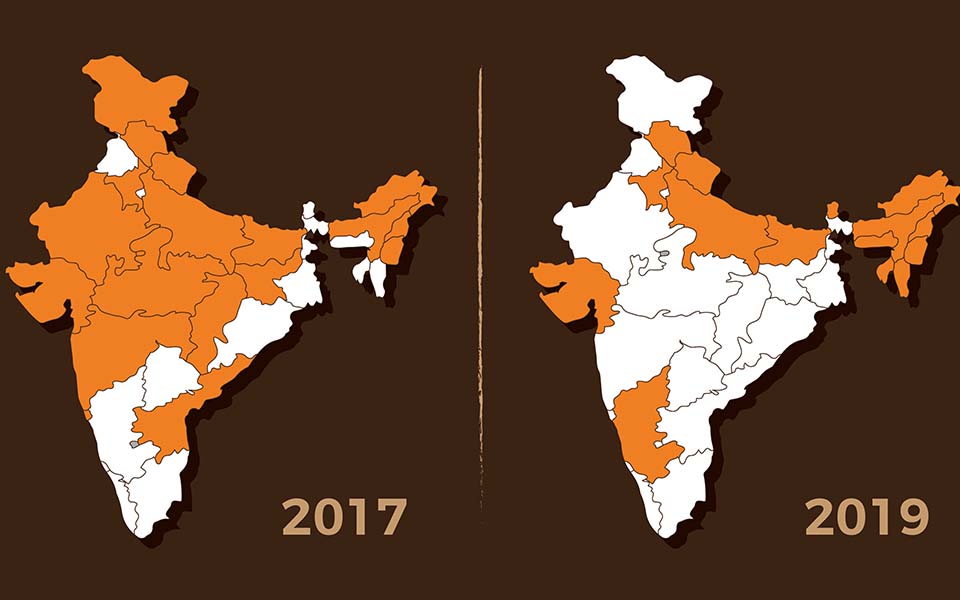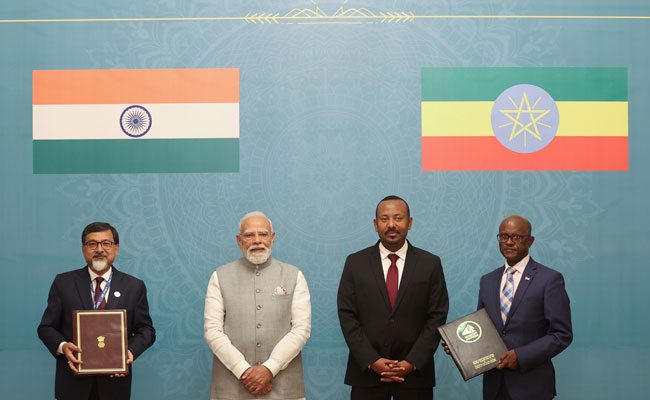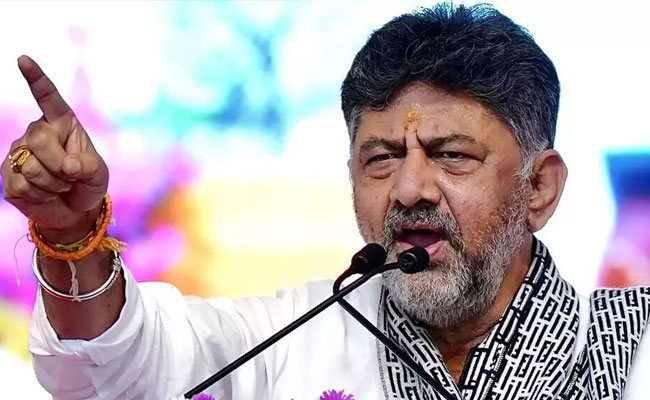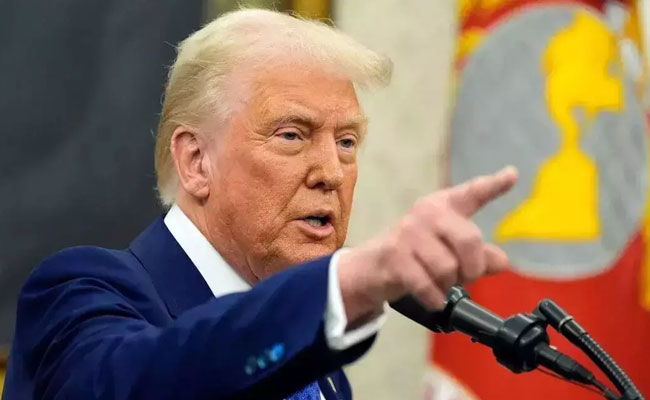New Delhi, Dec 23: With Jharkhand joining the growing list of states slipping out of BJP's rule, the party now governs mere 35 per cent of the country's landmass in comparison to over 71 per cent during its peak in 2017 when it was in power in the entire Hindi-speaking heartland.
Its string of losses in states despite the massive victory in the April-May Lok Sabha elections may force the party's top brass to revisit its strategy for the assembly polls as it prepares for the upcoming battles in Delhi and Bihar.
The percentage of the population being governed by the BJP in the states, either on its own or with its allies, now stands at around 43 per cent from over 69 per cent two years back, data analysis show.
What may be of more concern to the party is that its graph in state polls has been on a steady decline since 2018 when it lost its bastions of Madhya Pradesh and Chhattisgarh besides Rajasthan, and its huge victory in the Lok Sabha elections this year has not translated into gains in states.
Political watchers believe that the BJP may have to reconsider its tactic of backing leaders from non-dominant communities in assembly elections, as consolidation of Jat, Maratha and tribal votes against it is seen to be one of the reasons behind its below par performance in Haryana, Maharashtra and Jharkhand respectively.
Opposition parties did much better than expected in Haryana and Maharashtra, even though the BJP emerged as the single largest party in both the states even while losing many seats compared to its previous tally.
The party joined hands with rival Jannayak Janata Party to form the government in Haryana but was outsmarted in Maharashtra by the rival Congress-NCP alliance which joined hands with longtime BJP ally Shiv Sena to come to power at the saffron party's expense.
If the Haryana and Maharashtra results gave the BJP something to cling to, its defeat in Jharkhand was absolute as for the first time since the state's formation the party has not emerged as the single largest party.
The BJP always emerged as the single largest party in Jharkhand, once jointly with the Jharkhand Mukti Morcha (JMM).
Its face and incumbent chief minister Raghubar Das also appeared headed to defeat to BJP rebel Saryu Roy.
In all three states which have gone to the polls since Prime Minister Narendra Modi led the BJP to a landslide win in the general election, the party's vote share has fallen by big margins compared to the Lok Sabha polls.
The saffron party's vote share was more than 55 per cent in Jharkhand and 58 per cent in Haryana in the Lok Sabha elections. However, it slumped to 33 per cent and 36 per cent respectively in the assembly polls in these two states, held barely a few months after the general elections.
Significantly, the party has suffered losses in states at a time when it has been successful in fulfilling its longstanding ideological promises, including nullifying Article 370, criminalising the practice of triple talaq and enacting Citizenship Amendment Act.
The Supreme Court's verdict in favour of building a Ram Temple in Ayodhya was also a big boost to the BJP.
Top party leaders in election rallies spoke at length about these "achievements" under the Modi government but the voting returns have been less than what they might have expected.
Let the Truth be known. If you read VB and like VB, please be a VB Supporter and Help us deliver the Truth to one and all.
Addis Ababa (PTI): India and Ethiopia on Tuesday elevated their historical ties to a strategic partnership, as Prime Minister Narendra Modi held wide-ranging talks with his Ethiopian counterpart Abiy Ahmed Ali during which they discussed issues of bilateral and mutual interest.
Modi, who arrived here from Jordan on his maiden bilateral visit, was accorded a ceremonial welcome at the National Palace ahead of the bilateral talks, reflecting the vibrant India-Ethiopia relations rooted in shared history and a promising future.
"We are elevating India and Ethiopia relations to a strategic partnership. This step will provide new energy, new momentum and new depth to our ties," Prime Minister Modi said during the delegation-level talks.
He thanked PM Ali for his support in India's fight against terrorism. "The support of friendly countries in this struggle against terrorism holds great significance," Modi said.
"Today, we got the opportunity to deliberate on the key aspects of our cooperation, such as economy, innovation, technology, defence, health, capacity-building and multilateral cooperation. I am pleased that today, we have decided to double the student scholarship for Ethiopia in India," Modi said.
Modi said that India and Ethiopia have shared contact, dialogue, and exchange for thousands of years. The two countries, which are rich in languages and traditions, are symbols of unity in diversity, he added.
"Both countries are democratic powers committed to peace and the welfare of humanity. We are co-travellers and partners of the Global South. On international platforms, we have stood shoulder-to-shoulder," he said.
The two sides signed eight MoUs/agreements, including upgrading ties to 'Strategic Partnership', customs cooperation, establishing data center at the Ethiopian Foreign Ministry, UN Peacekeeping training cooperation, debt restructuring under G20, more ICCR scholarships and AI short courses for Ethiopians, and support for maternal and neonatal healthcare.
Modi said the African Union's headquarters in Ethiopia makes the country a meeting point of African diplomacy. "Inspired by the common vision of an inclusive world, in 2023, India ensured that the African Union became a G20 member," he said.
In 2023, during India’s G20 Presidency, the African Union was admitted as a permanent member of the G20.
Modi said that though this is his first visit, he felt a deep sense of belonging and warmth, reflecting the thousands of years of connection between the two countries.
On his part, Prime Minister Ali said the two countries share over thousands of years of connection through trade, diplomacy, education, culture and even in our food and traditions. "These ties continue to shape a deep friendship, collaboration and mutual respect between our people," he said.
"We also appreciate your consistent message that Africa's priorities must lead the partnership. These kinds of dignified, respectful messages for Africa are very important. Mr Prime Minister, keep pushing. That is the type of message we are expecting from all our trusted friends," Ali said.
He said this aligned fully with Ethiopia's development plan - African-owned, African-led, and African-defined.
"Today, we meet with a clear focus to shape a modern partnership, grounded in sovereignty, self-reliance and practical cooperation. Our cooperation is rooted in equality and South-South solidarity," he said.
"Our economy is performing strongly. Last year, we grew 9.2% and this year we are expecting 10.3% GDP growth. Besides GDP growth, our FDI inflow is also rising big time. India is the leading source for our FDI," he said.
"We have more than 615 Indian companies which are investing in Ethiopia. This all gives our cooperation a strong foundation of trust. I think our decision today that we elevate our historic relationship to a strategic relationship is the right decision," he added.
Ethiopia also conferred its highest award - The Great Honour Nishan of Ethiopia - on PM Modi. He is the first global head of state to receive this award.
Prime Minister Modi also went to the Friendship Park and Friendship Square in Addis Ababa with PM Ali.
In a warm and special gesture, PM Modi was earlier received by his Ethiopian counterpart at the airport and accorded a warm and colourful welcome.
"Ethiopia is a nation with great history and vibrant culture," Modi said.
PM Ali informed his Indian counterpart about the varieties of Ethiopian coffee during informal talks.
"At Addis Ababa airport, took part in a traditional Coffee Ceremony with Prime Minister Abiy Ahmed Ali. The ceremony beautifully highlights Ethiopia’s rich heritage," Modi said.
In a unique gesture, the Ethiopian Prime Minister drove Modi to the hotel.
On the way, he took a special initiative of taking PM Modi to the Science Museum and Friendship Park, which was not in the itinerary.
"Gratitude to Prime Minister Abiy Ahmed Ali for showing me glimpses of Ethiopian history and culture at the National Palace Museum in Addis Ababa. It was a powerful reminder of Ethiopia’s rich traditions," Modi said in a post on X.
The Nobel Peace Prize-winning Ethiopian PM’s special gestures show remarkable respect for Modi, sources said.
"Thank you Ethiopia for a welcome that was unforgettable. The Indian community showed remarkable warmth and affection. India-Ethiopia friendship is going to get even more robust in the times to come," Modi said.
When Modi arrived at the hotel, he was warmly welcomed by the members of the Indian community. Local artists performed dances. Some of them danced on the theme of the popular Hindi song 'Aisa Des Hai Mera' to welcome him.
On Wednesday, Modi will address the Joint Session of Parliament and share his thoughts on India's journey as the "Mother of Democracy" and the value that the India-Ethiopia partnership can bring to the Global South.
PM Modi arrived in Ethiopia from Jordan, where he held a one-on-one meeting with King Abdullah II at the Husseiniya Palace on Monday before the delegation-level talks.
India and Jordan also inked MoUs in the fields of culture, renewable energy, water management, digital public infrastructure and twinning arrangement between Petra and Ellora, aimed at giving a major boost to bilateral ties and friendship.
From Ethiopia, Modi will visit Oman on the final leg of this three-nation tour.





